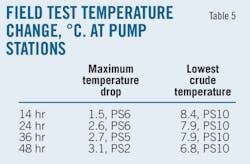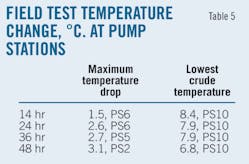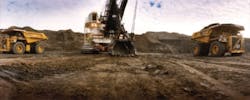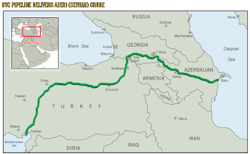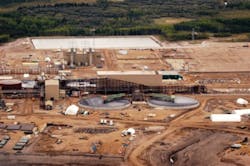Over the years various innovations have improved the economics for mining bitumen and reduced the effects of the mining operation on the environment in the Athabasca region of Northern Alberta.
Rob Birkholz, manager oil sands technology development for Shell Canada Energy, explained to Oil & Gas Journal the mining and processing operations Shell uses and highlighted some innovations that have improved economics and lessened the effect of the operations on the environment.
Currently Alberta has four ongoing mining operations in the Athabasca. Suncor Energy Inc., Syncrude Canada Ltd, Shell Canada Ltd., and Canadian Natural Resources Ltd. (Horizon) operate the four ventures that in 2009 produced 825,000 b/d of bitumen, according to Alberta's Energy Resources Conservation Board.
Shell's Muskeg River mine was the third bitumen mining venture to come on stream. Production started in 2003.
The Muskeg River mine (Fig. 1) and the Scotford upgrader are part of the Athabasca Oil Sands Project that Shell Canada Energy operates. Shell holds a 60% interest in AOSP and its partners are Chevron Canada Ltd. and Marathon Oil Sands LP, each holding a 20% interest.
The latest addition to AOSP is the Jackpine mine. Construction of Jackpine started in late 2006 and Shell expects start-up operations to commence in fourth-quarter 2010 with production ramping up to the 100,000 b/d capacity in 2011.
Shell also has the possibility of developing additional mines in the area such as the Pierre River mine, a proposed 200,000 b/d operation on the west side of the Athabasca River. Shell currently is assessing the resource and Shell notes that "the timing of any new development will be driven by several factors including: ongoing debottlenecking, as well as economic and environmental factors in Alberta."
Shell has designed the mines for a 30 year life.
Shell operates the Muskeg River mine with about 1,300 company employees and 1,100 contractors. Jackpine will add an additional 700 company employees and 800 contractors.
Excavation
The Muskeg River mine like other bitumen mines in Alberta now use trucks and shovels to excavate the bitumen (Fig. 2). Suncor's and Syncrude's older operations initially used bucket wheels or draglines but about 15 years ago the companies converted to trucks and shovels to simplify excavation and reduce maintenance costs compared with the relatively complex bucket wheel or dragline operations.
Birkholz noted that many of the mining procedures for oil sands have been used in the mineral processing industry for many years and that a lot of oil sands costs revolve around material handling. Birkholz emphasized that the ore in Muskeg River mine contains 10-12 wt % bitumen so that "we move a lot of sand to get a barrel of bitumen."
"Anything you can do to make that process more straightforward is helpful in bringing down the equivalent cost per barrel of oil sands compared with conventional oil," he said.
Shell uses 400-ton trucks and both diesel and electrically driven shovels for excavation and moves about 10,000-14,000 tonnes/hr of material. Typically the mine has 35 trucks and 8 electric shovels working at one time.
In the mine Shell continues to take cores for determining the grade of the ore so that it can adjust the process to maximize recovery. The bitumen pay zone is 50-75 m thick but also contains large amounts of clays that are left behind.
The Alberta cut off grade for bitumen that can be left unmined is 7-8%.
Ore processing
Fig. 3 shows the main elements of the process from excavation to the processing plant that produces clean bitumen and then to the pipeline that transports the bitumen to ASOP's upgrader near Edmonton. The processing plant has two trains, although for simplicity the figure only shows one.
The trucks dump the excavated ore into a double-roll crusher that reduces lumps that can be piano-sized to lumps of 16-in., although during the summer months the ore is relatively unconsolidated. A conveyor belt then moves these smaller lumps into a cylindrical storage silo that replaced a more conventional stock pile for temporary surge capacity for load leveling between the mining and the plant. Birkholz noted that the process likes a steady material feed instead of the ups and downs of truck operation.
Birkholz said the next step in the process involves a rotary breaker that was one of the innovations that Shell uses for reducing the size of the material to 2 in. The rotary breaker was a joint development of Shell and Suncor and is similar to equipment used in the coal industry, Birkholz said.
The rotary breaker slowly turns while water is added and 2-in. sized material exits as slurry through 2-in. holes and oversized material is rejected.
Birkholz said that in the past, the conventional method for conditional oil sands was with a hot-water rotating tumbler that had rotating drums into which hot water and steam were added. These were not energy efficient because they ran at relatively high temperatures, he said.
In the 1990s, it was found that a 2-km pipeline was as effective as the tumblers for conditioning oil sands and removing the bitumen from the sand particles. The pipeline operates more efficiently and at a lower cost, Birkholz said.
In the conditioning process, Shell adds generic sodium citrate and sodium hydroxide to help in the gravity-separation process and control the pH of the water. Air also is injected to assist in the separation process.
The 2-km pipeline transports the slurry to a primary separation cell (PSC) for gravity settling. In the PSC the bitumen froth floats off the top and sand and water leave from the bottom and, after secondary bitumen recovery in flotation cells, flows to a tailings pond from which water is recycled.
Birkholz explained that the term "froth" is a bit of a misnomer because it is not an airy milkshake substance but is more like molasses. The froth contains 60% bitumen, 30% water, with the remaining 10% being fine sand and clays.
About 70% of the bitumen may come off in the gravity-separation process, Birkholz said. A water layer lies between the bitumen and sand grains so that water and gravity easily separate the bitumen from the sand grains, he added. The bitumen attaches to air bubbles and floats to the top of the PSC.
Middlings and bottoms streams from the PSC are sent to flotation cells that involve an air sparging process. The process helps aerate the mixture and floats more bitumen off as froth because the bitumen attaches to the air bubbles.
Birkholz said the process recovers about 90% of the bitumen, which is a much higher recovery than for conventional oil production or in situ bitumen recovery processes.
The process recycles most of the water and only needs some addition of fresh water from the river. The plant also uses fresh water as makeup water for utilities such as the steam boilers.
Because the froth has a lot of air in it, the next step removes the air with a steam-contacting deaeration process. Getting the air out is essential for processing the hydrocarbons and aids in pumping the bitumen, Birkholz said.
After removal of the air, the bitumen goes to a tank for storage.
Water treatment
The material in the water from the extraction process contains about 70% sand and 30% finer material. Birkholz notes that the sand is clean and Shell uses it for constructing dikes in the mine (Fig. 4) and in other construction uses.
The material goes into a cyclone separation step in which the sand goes to the tailing pond and forms a beach while the finer tailings go to a tailings thickener (Fig. 5). Birkholz said that Shell is the only operator that uses tailings thickeners. He said because the water is still relatively warm in the thickeners, it is more energy efficient to remove the water while thickening the clays.
The tailings thickeners have a 90-m diameter in which a big rake turns around on top of the tailings to aid in water removal. Shell also adds flocculants to help recover the water that will be recycled.
The recycled water from the thickeners is warm so that it adds to the plant's efficiency, whereas the water from the tailings ponds is at ambient temperature and needs the addition of more heat, Birkholz explained.
In processing the bitumen, Shell uses about 85% recycled water and does not release any process-affected water directly back to the environment.
In 2009, Shell used about 89 million cu m of water of which 17% was fresh water. Shell has permits to withdraw about 0.6% or 118.6 million cu m from the Athabasca River's mean annual flow. Its current freshwater use is about a quarter of that amount.
Shell notes that as the industry increases bitumen production to 2.5 million b/d from the current 1.2 million b/d, it expects water withdrawals from the Athabasca to be 2.5% of the river's mean annual flow. It adds that the industry on average uses 2-3 bbl of fresh water for every barrel of bitumen produced.
Froth treatment
Shell uses a different type of froth treatment at the Muskeg River mine than other operators in Alberta. Those operations use a naphtha-based solvent that relies on diluting froth so that some solids are separated out through gravity separation and centrifugation, but enough solids remain so that the bitumen cannot be piped long distances, Birkholz said. He added that this is one reason that in these older operations the upgraders have been built on site and require cokers.
He said Shell was first commercially to use a paraffinic froth treatment process that was development jointly with the Canadian federal government at its CANMET Western Research center at Devon, south of Edmonton. Shell also field tested the process at its lease in a pilot plant.
In the process, a mixture of pentane and heptane cleans the bitumen. Birkholz explained that this is a single-step process of contacting the solvent with the bitumen to produce clean and dry bitumen with extremely low chlorides, solids, and water content. He added that this bitumen still requires a diluent for being piped long distances such as the 493 km to the Scotford upgrader. The process also rejects some of the asphaltenes but much less than a coking operation, he said.
The froth treatment at Muskeg River is a three-stage step with three vessels in which the solvent goes in a countercurrent fashion but most of separation takes place in the first stage vessel. The other two stages assist in improving bitument recovery.
The process recovers and recycles much of the solvent, although some is left in the bitumen as the diluent for transporting the bitumen in a pipeline.
The Scotford upgrader removes the solvent left in the bitumen and returns it to the Muskeg line in a separate pipeline.
Tailings streams off froth settlers are very fine asphaltene particles, fine clays, and fine sand in a water slurry that goes to a distillation operation for recovering residual solvent both for economic and environmental reasons, Birkholz said. The operations try to recover as much solvent as possible and recycle it back to the process, he added.
After removal of the solvent, the water slurry contains fines, rejected asphaltenes, and water.
Yecheng Long, froth treatment technology lead for Shell Canada Energy, noted that the naphtha-based froth treatment process resulted in very small 4-µm particles that require additional mechanical energy from a centrifuge to remove, whereas the paraffinic froth treatment aggregates the particles into 100-µm particles so that their removal is much easier.
Upgrader
When the bitumen arrives at the Scotford upgrader, the first process removes the diluent and sends it back to the Muskeg River mine in a separate pipeline.
The bitumen stream then goes to atmospheric and vacuum distillation. The light ends go to hydrotreating while the vacuum light, medium, and heavy gas oil goes to Shell's Scotford refinery for processing in a hydrocracker. The vacuum residue goes to an LC finer, which is a Chevron Lummis Global licensed residue hydroconversion process that adds hydrogen to the stream. The addition of hydrogen increases the bitumen volume by 3% compared with a 15-20% volume loss if the bitumen goes to a coker, Birkholz said.
He also added that the partial deasphalting in the paraffinic froth treatment boosts the conversion higher than what might be normal in the industry for a conversion process.
The naphtha-based froth treatment leaves 3-5% water and 1⁄2% particulate matter so that the bitumen has to go to a coker and cannot go into an LC finer, while the paraffinic froth treatment provides bitumen with about 500-ppm water and an equivalent amount of solvent and can be used in an LC fine, he explained.
At the upgrader the planned addition of a 100,000-b/d bitumen stream from the Jackpine expansion required Shell to add an additional LC finer.
Jackpine expansion
The Jackpine expansion includes a second-generation paraffinic froth treatment process that operates at a higher temperature then the process installed for the Muskeg River mine. The high-temperature process is much more efficient and it is unlikely that any new project would build the low-temperature version, Birkholz said.
Long noted that the second-generation froth treatment operates at 70-80° C. and the higher temperature increases the size of the particle aggregates formed in the process. The larger size of the particles speeds up the settling so that the unit is much small in size.
Long also said the energy used by the high-temperature process is much less and results in a reduction or carbon dioxide emissions of about 40,000 tonnes/year. He explained that the low-temperature version of the process receives the slurry at 45-50° C. and reduces the slurry temperature to 33° C. Heat then is added to the slurry to raise the temperature to the 90-100° C. required for the solvent-recovery unit.
The high-temperature version also receives 45-50° C. but operates at 70° C. so that much less heat is needed to raise the slurry temperature to 90-100° C.
The mine site at Jackpine has a double-roll crusher (Fig. 6), rotating breaker, a conditioning pipeline, and a primary separation cell. The high-temperature froth treatment process is at the Muskeg River mine site.
To comply with Alberta requirements for new bitumen mines, Shell also was required to build a lake that will be stocked with various fish species. Shell built the compensation lake during the last two winters (Fig. 7).
Tailings management
Tailings management and reclamation are a multifaceted solution of constantly moving material that is carefully managed and planned, Birkholz said. No single solution fits all and there is a lot of material to manage, he added.
Fig. 8 shows the two basic types of tailings confinement used. The external tailings facility is built during the removal of the overburden and the initial stages of the mine, while the in-pit tailings facility becomes available as portions of the pit are mined out. The dike walls in the external tailing facility typically are 50-70 m high.
Water is removed from tailings sand and fines stream through a variety of methods and, once deposited, these tailings become the foundation for future reclamation activities. Over this foundation, the reclamation work places a sand cap before placing on top the original overburden soil that was removed to access the bitumen in the mine.
The original removed overburden of the mine varies and Shell has to keep each type of overburden in a separate pile for future use in the reclamation process.
In 2007, Shell constructed a tailings test facility for conducting R&D on a variety of tailings management methods, Birkholz said. One of the processes developed was the nonsegregating tailings (NST) process, which combines coarse sand and fines with gypsum to produce a solid tailings material. Another test was on fines drying, which deposits multiple thin layers of fines to determine the drying time needed for each layer before the addition of another layer. Shell will be testing this method, referred to as atmospheric fines drying, on a demonstration scale in the field in 2010. Trafficability is one of the tests that is used to determine if the fines are sufficiently dry.
For deterring birds from landing on the tailings ponds, Shell uses a radar system that sets off various devices to ward off birds. These devices include propane cannons, falcon effigies, recorded screeches, and strobe lights.
Manuscripts welcome Oil & Gas Journal welcomes for publication consideration submissions of manuscripts about drilling, production, pipelines, LNG, and processing (refining, petrochemicals, and gas processing). These may be highly technical in nature and appeal or they may be more analytical by way of examining oil and natural gas supply, demand, and markets. An Author Guide that more fully explains acceptance criteria is available at www.ogj.com, click "Submit an article" at the top of the page. Or, you may contact the Chief Technology Editor ([email protected]; 713/963-6230), Oil & Gas Journal, 1455 West Loop South, Suite 400, Houston TX 77027; fax 713/963-6282. |
More Oil & Gas Journal Current Issue Articles
More Oil & Gas Journal Archives Issue Articles
View Oil and Gas Articles on PennEnergy.com
